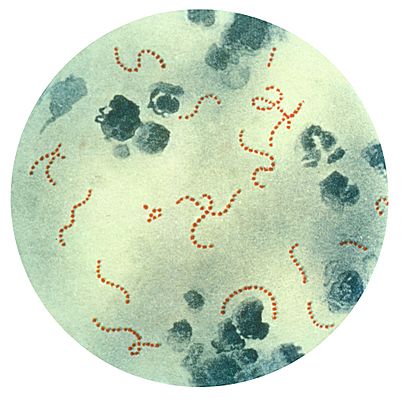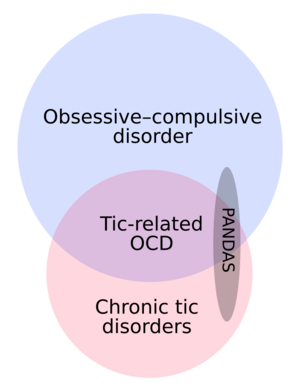PANDAS facts for kids
Quick facts for kids PANDAS |
|
|---|---|
 |
|
| Streptococcus pyogenes (stained red), a common group A streptococcal bacterium. PANDAS is speculated to be an autoimmune condition in which the body's own antibodies to streptococci attack the basal ganglion cells of the brain, by a concept known as molecular mimicry. |
PANDAS stands for Pediatric Autoimmune Neuropsychiatric Disorders Associated with Streptococcal Infections. It's a name given to a group of children who suddenly develop obsessive-compulsive disorder (OCD) or tic disorders. The idea is that these symptoms might be caused by a type of strep infection, like strep throat.
Scientists who first described PANDAS in 1998 thought that the body's immune system, after fighting a strep infection, might accidentally attack parts of the brain. This idea is called an autoimmune reaction. This could then lead to sudden changes in behavior, like new OCD symptoms or tics.
However, PANDAS is a debated topic among doctors and scientists. It's not fully proven or accepted as a separate medical condition. Because of this, other similar ideas have been suggested, like Pediatric Acute-onset Neuropsychiatric Syndrome (PANS). PANS is a broader idea that includes sudden OCD or tic symptoms that might be caused by different things, not just strep infections.
There isn't a special test to confirm if someone has PANDAS. Doctors usually treat the symptoms of PANDAS the same way they treat regular OCD or Tourette syndrome. Some experimental treatments have been tried, but many are not fully supported by scientific evidence.
Contents
What are PANDAS Symptoms?
Children who might have PANDAS often show a very sudden start of symptoms. These can include:
- Tics: These are sudden, fast, repeated movements or sounds that a person can't control, like blinking a lot or clearing their throat.
- Obsessions: These are unwanted thoughts or worries that get stuck in your mind.
- Compulsions: These are actions you feel you *have* to do over and over to try and make the obsessions go away, like washing your hands many times.
Besides OCD and tics, children might also have other problems that come and go, such as:
- Feeling very emotional or having quick mood changes.
- Wetting the bed (enuresis).
- Feeling very anxious.
- Changes in handwriting.
In the PANDAS idea, these sudden symptoms are thought to appear after a strep throat infection.
How PANDAS is Classified
PANDAS is thought to be an autoimmune disorder. This means the body's immune system, which normally fights off germs, mistakenly attacks its own healthy cells. In PANDAS, it's thought to affect parts of the brain, leading to tics, obsessions, and other symptoms. However, as of 2021, there isn't strong proof that PANDAS is an autoimmune disorder.
PANS and other similar ideas are also thought to be autoimmune conditions, but this is still being researched.
What Causes PANDAS?
The idea that strep infections cause PANDAS is still debated and not fully proven. The theory is similar to how rheumatic fever works. Rheumatic fever is a serious illness that can happen after a strep infection. In rheumatic fever, the body's immune system attacks the heart, joints, or brain. When it affects the brain, it can cause a condition called Sydenham's chorea, which involves uncontrolled movements.
In PANDAS, it's thought that the immune system's antibodies (which are like tiny soldiers fighting germs) get confused. They might attack parts of the brain called the basal ganglia, which help control movement and behavior. This confusion is called "molecular mimicry" – meaning the strep bacteria look similar to some brain cells, so the antibodies attack both.
However, studies trying to prove this link have had mixed results. Some studies show a connection between strep infections and sudden worsening of symptoms in children with PANDAS. Other studies have found no link. The PANS idea suggests that other things, like genetics or other infections, could also cause these sudden symptoms.
Scientists have not consistently found specific antibodies in children with PANDAS or PANS that would clearly show an autoimmune problem.
Diagnosing PANDAS
PANDAS and PANS are not officially listed as separate diagnoses in the main guide for mental disorders, the Diagnostic and Statistical Manual of Mental Disorders (DSM-5). This means most doctors don't use PANDAS as a formal diagnosis.
In 1998, some researchers suggested five main signs for PANDAS:
- Having a tic disorder or OCD.
- Symptoms starting before puberty (around age 12).
- Symptoms starting very suddenly or getting much worse in episodes, with times of getting better.
- A clear link between the start or worsening of symptoms and a recent strep infection.
- Having extra movements, like hyperactivity or jerky movements, when symptoms are bad.
For PANS, the suggested signs are a sudden start of OCD or problems with eating, along with other severe changes like:
- Anxiety or depression.
- Being very irritable.
- Going backward in development (like acting younger).
- Doing worse in school.
- Problems with senses or movement.
- Sleep or bladder problems.
It's important to know that there's no lab test to confirm PANDAS. Doctors diagnose it based on symptoms. Some doctors might diagnose PANDAS too often, even when the child doesn't fully meet the suggested signs. Because PANDAS symptoms can look like many other conditions, it can be hard for doctors to be sure. For example, sudden tics are also common in Tourette syndrome.
Treating PANDAS
The treatment for children thought to have PANDAS is usually the same as for regular OCD and Tourette syndrome. This includes:
- Cognitive behavioral therapy (CBT): A type of talk therapy that helps people change their thinking and behavior.
- Medications: Like selective serotonin reuptake inhibitors (SSRIs), which are used to treat OCD.
If symptoms are very bad, doctors might suggest seeing specialists. They will also treat any active strep infections with antibiotics.
Experimental Treatments
Some treatments are considered experimental for PANDAS and PANS, meaning they are still being studied and are not widely recommended. These include:
- Antibiotics: Taking antibiotics regularly to prevent infections. However, there's not enough proof this works for PANDAS/PANS, and using too many antibiotics can lead to problems like antibiotic resistance.
- Immunomodulatory therapies: These treatments aim to change how the immune system works. Examples include intravenous immunoglobulin (IVIG) or plasma exchange. These treatments can have serious side effects and are usually only considered for very severe cases in special research studies.
Many medical groups and experts, including the American Heart Association and the Tourette Association of America, do not recommend these experimental treatments outside of formal research studies. They emphasize treating the symptoms of OCD and tics with standard, proven methods.
PANDAS in Society
The discussion around PANDAS has become quite public, especially online and in the news. Many families who believe their children have PANDAS or PANS share their stories. This has led to a lot of debate among doctors, scientists, and the public.
Some experts worry that too much focus on PANDAS without strong scientific proof could lead to unnecessary treatments, like too many antibiotics. Others feel that more research is needed to understand these conditions better and help affected children. The goal is to find the best ways to help children with sudden-onset OCD and tic disorders, whether or not they are linked to strep infections.
History of PANDAS
PANDAS was first described in 1998 by Dr. Susan Swedo and her team at the US National Institute of Mental Health. They noticed a pattern in some children where OCD and tic symptoms seemed to appear suddenly after strep infections.
Over time, some doctors and scientists questioned the PANDAS idea because the evidence wasn't strong enough. This led to the idea of PANS (Pediatric Acute-onset Neuropsychiatric Syndrome) in 2012. PANS was created to be a broader term for research, including children with sudden OCD or eating problems and other symptoms, even if a strep infection wasn't the cause.
The debate continues today, with ongoing research to better understand these complex conditions.
Images for kids
See also
 In Spanish: PANDAS para niños
In Spanish: PANDAS para niños



